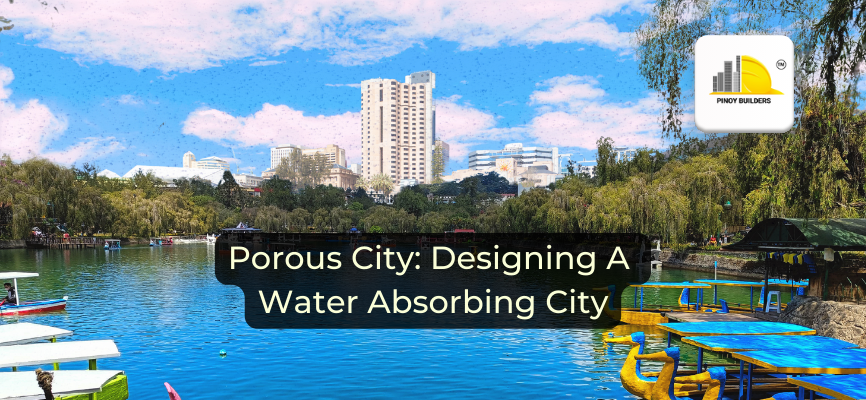The Philippines is highly vulnerable to severe climate change, which makes the concept of designing cities with water catchment systems not just innovative but essential. Emphasizing city-wide water catchments as a proactive solution that is necessary to increase the storm and drought preparedness of the country, aiming to mitigate flood risks and enhance urban resilience for the benefit of the Filipino people.

Earlier this year, the Metropolitan Manila Development Authority (MMDA) developed designs for a rainwater catchment system and distributed the blueprints to local government units (LGUs) in Metro Manila. The main objective of the facilities is to reduce the effects of the expected severe drought brought about by El Niño, but it delivers more benefits than storing rainwater. In this article, we will discuss the importance of water catchment systems, how it works, its benefits, and how it can make resilient cities in the Philippines.
The Importance of Flood Preparedness in the Philippines
The Philippines’ geographical location and climate conditions make it exceptionally prone to floods. Situated in the typhoon belt of the Pacific, the country experiences an average of 20 typhoons annually, with many bringing heavy rains that lead to widespread flooding. Historical data underscores the devastating impact of these floods; for instance, Typhoon Ondoy (Ketsana) in 2009 inundated Metro Manila, affecting millions and causing billions of pesos in damage.
The socio-economic and health implications of frequent flooding are profound as well. Floodwaters often carry pollutants and pathogens, leading to waterborne diseases. Moreover, floods disrupt livelihoods, damage infrastructure, and exacerbate poverty, particularly in densely populated urban areas. Therefore, proactive flood management strategies are imperative to safeguard communities and foster sustainable development.
Concept and Benefits of City-Wide Water Catchments
Water catchments are systems designed to collect and manage rainwater, ultimately reducing the volume of runoff and the possibility of flood risks. These systems can take various forms, such as rain gardens, permeable pavements, green roofs, and detention basins. By capturing and storing rainwater, they help prevent urban flooding, conserve water, and support green spaces, thereby enhancing the quality of urban life.

The redesign plans for Copenhagen’s Hans Tavsens Park
For example, Copenhagen has award-winning redesign plans for water catchments that could transform potential flood risks into opportunities for sustainable urban development. These cities serve as models for how integrated water management can create resilient urban environments that thrive despite climatic challenges.
Design and Implementation of Water Catchments in the Philippines
In the Philippines, various types of water catchments can be adapted to fit urban landscapes. Rain gardens, which use native plants to absorb rainwater, and permeable pavements, which allow water to seep through surfaces, are particularly suitable for densely populated areas. Green roofs, another innovative solution, not only absorb rainwater but also provide insulation and reduce urban heat island effects.

Small, but effective: A water catchment system in Davao City.
Some Filipino cities have begun experimenting with water catchment systems. For example, Metro Manila has introduced small-scale rain gardens in public parks, while Cebu has implemented permeable pavements in select areas. However, the potential for expanding these initiatives is vast. Major cities like Quezon City and Davao could significantly benefit from larger-scale water catchment projects, strategically located in flood-prone zones.

A man-made lake in Laoag City to harvest rainwater for the use of the community.
Challenges And Considerations Of City-Wide Water Catchments
Implementing city-wide water catchments in the Philippines poses several challenges. Securing funding for large-scale infrastructure projects is a primary concern, as is integrating these systems into existing urban plans. Public awareness and engagement are crucial for the success of these initiatives—there is a need for education to encourage communities to understand and support the benefits of water catchments.
Environmental and technical considerations are also critical. Effective design and maintenance of water catchments require expertise and ongoing monitoring to ensure they function correctly. Additionally, supportive policies and regulatory frameworks are essential to facilitate widespread adoption and encourage investment in green infrastructure.
However, the need for water catchment systems in the country remains blaring. Architect Fides Garcia-Hsu, Vice-President at SM Engineering Design and Development emphasized it in an interview with the Business World Online.
“We approach it two ways: resilience — to help communities be flood-free; and sustainability — to optimize water which is a scarce resource so we can use it for other purposes rather than just waste it”
By taking these proactive steps, the Philippines can pave the way for a new era of resilient and sustainable urban living, transforming challenges into opportunities for growth and innovation.



